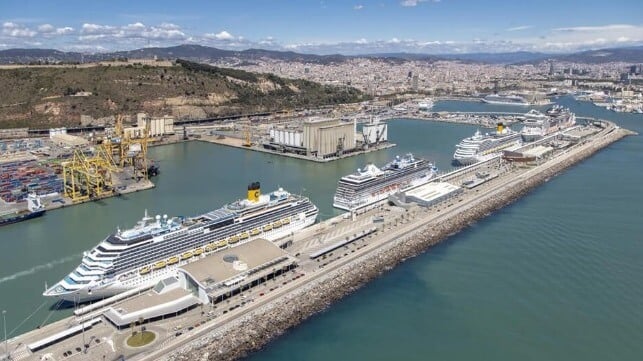Port of Barcelona Reduces Cruise Terminals to Limit Overtourism

The city of Barcelona is taking action to address the growing complaints of overcrowding and overtourism that critics say is linked to the cruise ships. The city, which claims to be the largest cruise port in Europe unveiling plans to redevelop its seaport, a move intended to increase the sustainability of the port while also reducing the number of tourists arriving at the popular destination.
After recording a 20 percent increase in the number of cruise ship passengers between 2018 and 2024, Barcelona now wants to put a limit on the growth of cruise tourism. The city recorded 3.65 million passengers last year, and reports a 21 percent increase in calls and a 20 percent increase in passengers to 1.2 million in the first five months of 2025.
Barcelona Mayor Jaume Collboni, a member of the Catalan Socialist party and who has openly been pushing for limiting cruise ship overtourism, including proposing the raising of tourist tax for passengers, is spearheading the push for the redevelopment of the terminals. This comes after the Barcelona City Council and the Port of Barcelona signed a new agreement designed to reduce the number of cruise ship terminals from seven to five by 2030. The net effect will be reducing Barcelona's maximum cruise capacity by 16 percent from 37,000 to 31,000 passengers per day.
“For the first time in history, a limit is being placed on the growth of cruises in the city,” said Collboni, who went ahead to express gratitude to the Port of Barcelona for “its effort in understanding and empathy” in recognizing that the growth of cruise ship tourism cannot be infinite and needed to be reduced. “The current management of tourism involves setting limits and managing better.”
Following the signing of the agreement, a total of €185 million ($215 million) will be invested in undertaking an overhaul of cruise terminals at the port and investment in other infrastructural projects whose ultimate goal is to reorganize cruise activity to make it more sustainable.
The hallmark of the agreement involves reducing the number of cruise terminals from seven to five by demolishing current terminals A, B, and C at the Adossat wharf, and building a new terminal on the site of terminal C. The new terminal will be Barcelona’s only public cruise terminal with a capacity to serve 7,000 passengers and will prioritize home port cruises and small vessels. The port will have five cruise terminals, four of which will be privately owned and one of which will be public.
Apart from the terminals, the Port of Barcelona will also invest €50 million ($58 million) to fully overhaul the 610-metre-long section of wharf that currently houses terminals A and B. Barcelona highlights that the three terminals which will be demolished were nearing the end of their useful life and that its critical to build new facilities that are better suited to the current requirements of the cruise industry.
The wharf overhaul will facilitate the installation of the onshore power supply systems to enable cruise ships to plug in to the electrical grid while at berth, ultimately cutting down on emissions. Barcelona has been cited as one of Europe’s biggest ports that has been slow in onshore power investments, something that could see the port fail to meet the European Union’s 2030 deadline for shore power provision.
Work on the projects is expected to commence next year and is slated for completion in 2030 when Terminal C will be fully operational.
“The signed protocol culminates the modernization plan for the Adossat Wharf, which began a few years ago with the goal of upgrading port infrastructure and strengthening the competitiveness of the Port of Barcelona,” said José Alberto Carbonell, Port of Barcelona President.
Despite the cruise industry being one of the key economic sectors in Barcelona, generating €1 billion ($1.1 billion) annually and contributing €562 million ($653 million) directly to Catalonia's gross domestic product, the city contends that a more orderly and efficient maritime tourism model is necessary to make the sector sustainable. The city will also seek to encourage cruise passengers to extend their stay onshore.
